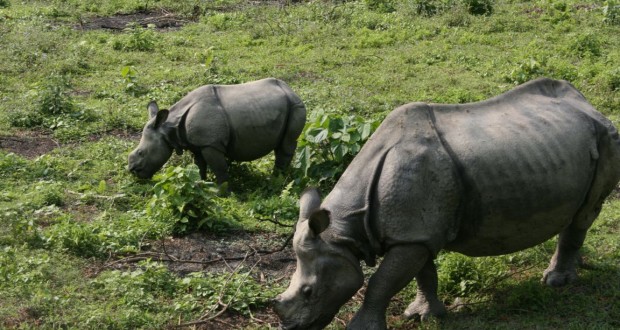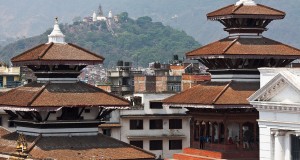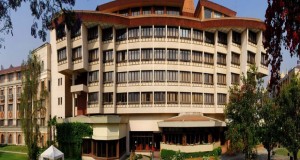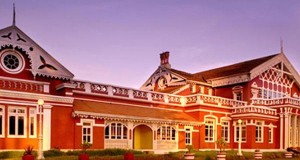Chitwan (Rapti Valley) is situated in the inner terni region of Nepal and can be reached in 6 hours by road or half an hour by flying from Kathmandu. There are two airports close by: Bharatpur and Meghauli; 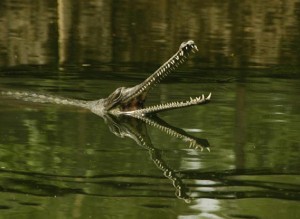 the latter is used by visitors booked in at Tiger Tops Jungle Lodge. The nearest bus-stop for the Royal Chitwan National Park is Tadi Bazaar on the East–West Highway, 15 km (9 1/3 miles) from Narayanghat. From Tadi bazaar, there is a choice of transport—foot, jeep, bicycle, oxcart, the occasional elephant—to cover the 7 km (4 1/3 miles) distance to Sauruha, the entrance to the Park.
the latter is used by visitors booked in at Tiger Tops Jungle Lodge. The nearest bus-stop for the Royal Chitwan National Park is Tadi Bazaar on the East–West Highway, 15 km (9 1/3 miles) from Narayanghat. From Tadi bazaar, there is a choice of transport—foot, jeep, bicycle, oxcart, the occasional elephant—to cover the 7 km (4 1/3 miles) distance to Sauruha, the entrance to the Park.
Chitwan National Park is the most famous wildlife reserve in Nepal, and among the most important in Asia. Thousands of visitors come every year to see the wide range of wildlife. The greater one-horned rhinoceros was the prime reason for the park being established in 1961. Other animals include four species of deer, sloth bear, leopard, wild boar, crocodile, and tiger. Over 350 species of birds provide a major attraction for ornithologists.
Apart from Tiger Tops, there are several other safari camps including Machan, Temple Tiger, Island Jungle Resort, Gaida Wildlife, Chitwan Jungle Lodge and Jungle Camp. The last one is particularly good for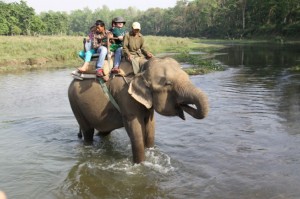 bird-watchers. Visitors are taken into the park by experienced guides on elephant-back, in jeeps or on foot, to view the wildlife in their natural environment.
bird-watchers. Visitors are taken into the park by experienced guides on elephant-back, in jeeps or on foot, to view the wildlife in their natural environment.
Because of its natural riches Chitwan has become quite crowded, but there are other more remote National Parks in Nepal. These are not so developed, and camps have a more natural atmosphere and surroundings. Most have luxury lodges and have developed their own infrastructure. Unfortunately, this does mean that individual tourists not booking safari trips with these lodges may find it difficult going. One of the best, Royal Bardia National Park, is also in the terai, but further west than Chitwan: 4 hours from Nepalganj airport, with headquarters at Thakurdwara, although the park office is likely to move to Motipur shortly. Accommodation is confined to Tiger Tops Karnali Lodge and its Tented Camp on the bank of the Churia river. Bardia has a good number of tiger, blackbuck, crocodiles and wild boar, an extensive bird life and the rare Gangetic freshwater dolphin.
RECREATION
Compared to the rest of the country, Kathmandu provides the best 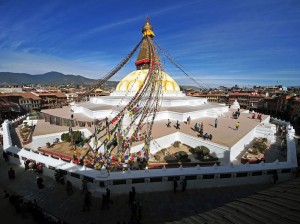 facilities for entertainment and recreation. There are a number of movie theatres which mainly run Indian films. The video culture has caught on and most hotels have TV and video in their lounges; and, in the upper bracket hotels, in guest-rooms as well. Western films are also shown in European and American cultural centres. There is virtually no nightlife after 10 pm, barring in the large hotels where discotheques stay open till the small hours. Some bars in the Thamel area stay crowded till late at night.
facilities for entertainment and recreation. There are a number of movie theatres which mainly run Indian films. The video culture has caught on and most hotels have TV and video in their lounges; and, in the upper bracket hotels, in guest-rooms as well. Western films are also shown in European and American cultural centres. There is virtually no nightlife after 10 pm, barring in the large hotels where discotheques stay open till the small hours. Some bars in the Thamel area stay crowded till late at night.
Nepal also has casinos. The Soaltee Oberoi Hotel runs Casino Nepal on its premises; only Indian rupees and foreign exchange can be used to buy the chips and Nepalis are not allowed in. Casino Anna opened at the Taj Annapurna Hotel in August 1992.
Some hotels arrange folk-dances and musical shows by local troupes and invited artists. Everest Culture Society at Lal Durbar near Yak & Yeti Hotel, and New Himalchuli 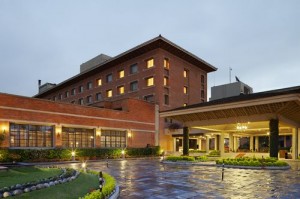 Culture Group of Lazimpat perform every evening. Some Indian res- taurants, particularly Ghar-e-Kebab in Hotel de Annapurna and Far Pavilions in Everest Hotel, feature Indian classical music every evening.
Culture Group of Lazimpat perform every evening. Some Indian res- taurants, particularly Ghar-e-Kebab in Hotel de Annapurna and Far Pavilions in Everest Hotel, feature Indian classical music every evening.
Sports. Kathmandu has olympic-sized public swimming-pools at the National Stadium and at Balaju, but these are usually crowded. The hotel pools are much more exclusive, and the pools at Hotel del’ Annapurna, Shangri-La, Everest, Soaltee Oberoi can be used for a small fee. There are tennis courts, sauna, beauty and massage parlours and exercise facilities at major hotels like Hotel de l’Annapurna, Everest, Yak & Yeti and Soaltee Oberoi.
SHOPPING
Kathmandu is a buyers’ market. Even without stepping into regular shops, visitors can buy all kinds of goods from traders and hawkers, who congregate in the tourist spots and tend to swoop down on unwary visitors.
Very often these vendors, and regular shops in the various bazaars sell fake or over-priced products. Shop around for the real thing and the right price. Government- run or controlled shops are the safest bet. The best buys include handicrafts, metalware, carpets, stone-sculpture, wood carvings, prayer wheels from Jawalakhel Tibetan camp, clothes, Tibetan trinkets, and Tibetan woollen jackets especially. Some of the better stores are Nepalese Handicrafts Centre near Jawalakhel which has a selection of goods from all over Nepal, Tibet Ritual Art Gallery for antiques and rare art objects, Paean Industrial Estate and Bhaktapur Crafts Centre for wood carving, metalwork and thangkas.

